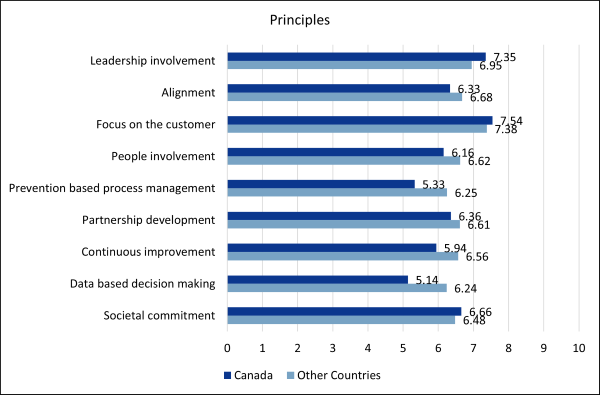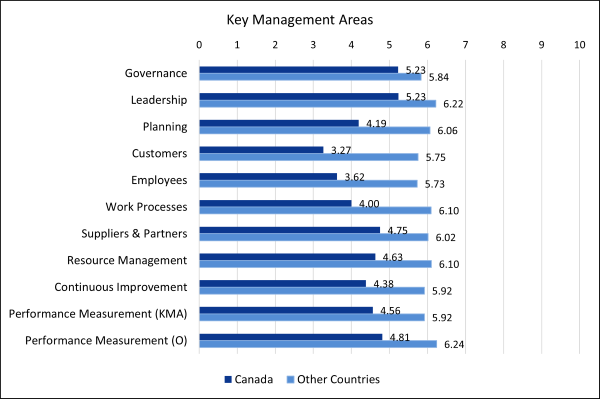Assessing Canada’s global performance in organizational excellence
 By Dawn Ringrose
By Dawn Ringrose
Dawn Ringrose MBA, FCMC is Principal of Organizational Excellence Specialists and author of the Organizational Excellence Framework publication and accompanying turnkey toolkit. She currently serves on the executive team of the Organizational Excellence Technical Committee QMD ASQ and the board of the ISCM Foundation.
How is Canada doing internationally when it comes to organizational excellence, including principles and best management practices?
The “Global Assessment on the Current State of Organizational Excellence” was launched in May 2015 by the Organizational Excellence Technical Committee QMD ASQ. It was supported by the Global Benchmarking Network, International Organization for Standardization’s Technical Committee 176, and International Academy for Quality and was conducted voluntarily by Organizational Excellence Specialists in Canada.
Since that time, three interim reports have captured the aggregate results. To date, the study has attracted 2,931 respondents from organizations across size, industry sector and region. It has provided feedback on the extent to which organizations are characterized by a culture committed to excellence and have deployed the best management practices common to high performing organizations.
With 317 respondents from Canadian organizations, participation has been impressive to date, serving to shed light on what is going well and what needs to improve.
How committed to excellence are Canadian organizations?
The aggregate results suggested that most respondents rated the nine Principles, characterizing a culture committed to excellence, quite positively (Figure 1). The highest-rated Principles were Leadership Involvement and Focus on the Customer, while the lowest-rated were Prevention Based Process Management and Data-Based Decision Making.
Canadian respondents had a slightly lower average rating on these Principles, compared with their international counterparts (6.73 and 6.91, respectively). Higher ratings were provided by: business, leader role, large-size (1000+ employees), service sector and professional, scientific and technical industry sector.
On the flip side, lower ratings were provided by government, staff role, small-size (26-100 employees), manufacturing sector and two specific industry sectors: Public Administration, Defence & Social Security; and Agriculture, Forestry & Fishing.
Figure 1 – Principles

Are Canadian organizations deploying best management practices?
On the extent to which Best Management Practices were deployed, the ratings on the Key Management Areas were significantly lower than the ratings on the Principles. This is where the rubber hits the road for many organizations, as the Key Management Areas (see Figure 2) are comprised of 51 Practices for micro-size organizations and 102 Practices for small, medium and larger-size organizations.
Canadian respondents provided lower average aggregate ratings compared with “Other Countries” (4.43 and 5.99, respectively). The highest-rated areas were Governance and Leadership while the lowest-rated were Customers and Employees.
These results suggested there is indeed opportunity for improvement if Canadian organizations wish to keep pace with their international counterparts.
Figure 2 – Key Management Areas

Self-assessment of organization can identify areas for improvement
To improve ratings on the Principles and Practices in the Key Management Areas, respondents must consider the direct relationships between principles and key management areas.
With respect to the degree to which the culture is committed to excellence, each Principle has direct relationships with specific Practices and low-rated items are touch points that spell opportunities for improvement.
Similarly, the degree to which the Practices are deployed also identify opportunities for improvement. Sometimes the opportunities cluster in certain Key Management Areas or follow along a particular theme. On the basis of the organization’s strategic imperatives, action can be taken in order of priority.
One of the best ways to obtain these ratings is to engage a good cross-section of employees in a self-assessment of the organization. The exercise is invaluable as it reveals what is going well, what needs to improve and shares open-ended comments that provide rational for the ratings. And it never fails — within these comments are often surprises for leadership and quick wins that can be implemented right away!
This self-assessment can be accomplished in 10 steps that are guided by a qualified professional and that offer a simple, straightforward, time efficient and cost-effective approach:
- Become familiar with the “What Is” and “How to” of excellence by downloading the Organizational Excellence Framework publication at no charge
- Meet with leadership to discuss strategic imperatives and the assessment
- Orient employees to excellence and describe the self-assessment tool
- Invite employees to participate in the self-assessment
- Report the aggregate results in a presentation
- Present the more detailed findings in an action-oriented report
- Have leaders determine priority and assign responsibility to employees for action items
- Assign an internal Excellence Manager to establish a regular meeting schedule
- Support employees as required with training, coaching or consulting assistance
- Repeat the assessment every year or two to monitor progress
This way of working is most beneficial to organizations as it ensures that knowledge is transferred, skill is developed and both remain within the organization!
Achieving organizational excellence requires policy and investment
So, what does Canada need to do at all levels with respect to policy and investment?
Policy will help to tackle challenges and pursue opportunities. Thus, each organization in a general sector (e.g. government or business or non-profit) must set a policy for excellence that will capture the commitment to continually improve.
For example: “Through the use of these guiding principles, everyone in the organization is accountable for satisfying the customer with our services.” This policy would then be supported by a goal statement such as: “To continually improve customer satisfaction,” and with an objective statement such as: “To improve customer satisfaction by 5 percent per year.”
To achieve this objective, there would be related undertakings that focus on meeting customer requirements to influence the level of customer satisfaction (e.g. reliability, responsiveness, assurance, empathy, tangibles).
To act on the policy, investment will be necessary. Surprisingly, most of the investment will be allocating employee time to work on strengthening practices detailed in the action-oriented report (e.g. practice, activity steps, responsibility, timing, method of measurement, out-of-pocket cost). Depending on the current state of the organization, some funding may be required for an external qualified professional to guide and provide support services that may not be available internally (e.g. training, coaching, consulting).
There will also be opportunities for the three general sectors (government, business, non-profit) to work together to improve the performance of a specific industry sector (e.g. agriculture, education, healthcare). Most of the heavy lifting will have been done by the organizations, so it will just be a matter of establishing a coalition of willing leaders that wish to raise the excellence bar even higher by taking action, working collaboratively and monitoring progress.
A particularly important example today is the Indigenous economy (which has the potential to grow from nearly $50 billion in 2020 to $100 billion) and the stakeholders that are keen to build, manage and grow this economy. It is exciting indeed, as these stakeholders can leverage “What we know works” and ensure that all organizations involved have implemented the practices. There will be no reinventing the wheel!
Realizing the “Formula for Success”
The snapshot of Canada has revealed the current state of excellence across organizations and identified where to focus effort in order to improve performance. By building on strengths and addressing opportunities for improvement, Canadian organizations will be able to realize the “Formula for Success” that has been available and validated by global research over the past three decades:
Formula for Success = Implement the practices, Develop a culture committed to excellence, Achieve exceptional results across a balanced set of measurement.
Global research tells us that exceptional results include, but are not limited to: good governance, trust in leadership, customer delight, employee engagement, continually improving work processes, strong supplier and partner relationships, better utilization of resources, balanced system of measurement, and financial results.
Successfully applying this formula will enable Canadian organizations to improve and keep pace with their international counterparts.
When you think about it, higher-performing organizations contribute to the economy, trade and resident quality of life. These organizations hire employees, buy goods and services, donate time and money to the community, trade with others, attract investment and influence the reputation and brand image of the country.
So, it is important to take full advantage of what we know works and to leverage it accordingly. By working together, we can move Canada from where it is today (current state) to where it should be tomorrow (desired future state).
R$
Events For Leaders in
Science, Tech, Innovation, and Policy
Discuss and learn from those in the know at our virtual and in-person events.
See Upcoming Events
You have 0 free articles remaining.
Don't miss out - start your free trial today.
Start your FREE trial Already a member? Log in
By using this website, you agree to our use of cookies. We use cookies to provide you with a great experience and to help our website run effectively in accordance with our Privacy Policy and Terms of Service.





